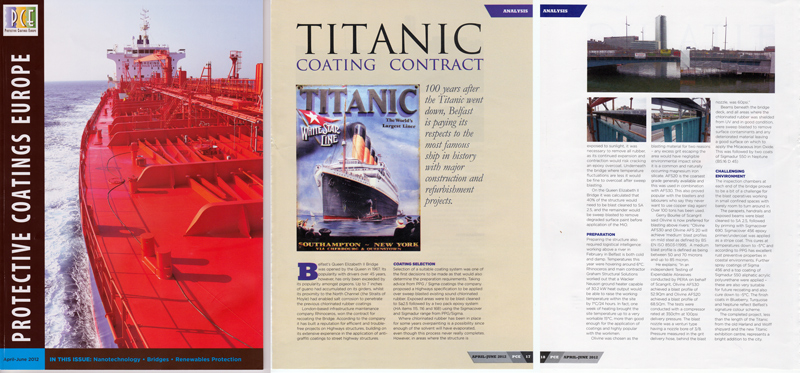
This article is reprinted from the May 2012 issue of PROTECTIVE COATINGS EUROPE magazine
100 years after the Titanic went down, Belfast is paying its respects to the most famous ship in history with major construction and refurbishment projects.
Belfast’s Queen Elizabeth II Bridge was opened by the Queen in 1967. Its popularity with drivers over 45 years, however, has only been exceeded by its popularity amongst pigeons. Up to 7” of guano had accumulated on its girders, whilst its proximity to the North Channel (the Straits of Moyle) had enabled salt corrosion to penetrate the previous chlorinated rubber coatings
London-based infrastructure maintenance company RHINOCEROS won the contract for recoating the Bridge. According to the company it has built a reputation for efficient and trouble-free projects on Highways structures, building on its extensive experience in the application of anti-graffiti coatings to street highway structures.
COATING SELECTION
Selection of a suitable coating system was one of the first decisions to be made as that would also determine the preparation requirements. Taking advice from PPG / Sigma coatings the company proposed an MiO (HA item 112) to be applied over sweep blasted existing sound chlorinated rubber. Exposed areas were to be blast cleaned to Sa2.5 followed by a two pack epoxy system (HA items 115. 116 and 168) using the Sigmacover and Sigmadur range from PPG/Sigma.
Where chlorinated rubber has been in place for some years overpainting is a possibility since enough of the solvent will have evaporated, even though this process never really completes. However in areas where the structure is exposed to sunlight it was necessary to remove all rubber, as its continued expansion and contraction would risk cracking an epoxy overcoat. Underneath the bridge where temperature fluctuations are less it would be fine to overcoat after sweep blasting.
On the Queen Elizabeth II Bridge it was calculated that 40% of the structure would need to be blast cleaned to SA 2.5, and the remainder would be sweep blasted to remove degraded surface paint before application of the MiO.
Preparing the structure also required logistical intelligence: working above a river in February in Belfast is both cold and damp. Temperatures this year were hovering around 6 degrees. RHINOCEROS and main contractor Graham Structural Solutions worked out that a Wacker Neuson ground heater capable of 30.2 kw heat output would be able to raise the working temperature within the site by 1 degree/24 hours. In fact one week of heating brought the site temperature up to a very workable 15 degrees, more than good enough for the application of coatings and highly popular with the workmen.
Olivine was chosen as the blasting material for two reasons – any excess grit escaping the area would have negligible environmental impact since it is a common and naturally occurring magnesium iron silicate. AFS20 is the coarsest grade generally available and this was used in combination with AFS30. This also proved popular with the blasters and labourers who say they never want to use copper slag again! Over 100 tons has been used.
Gerry Bourke of Scangrit said Olivine is now preferred for blasting above rivers: “Olivine AFS30 and Olivine AFS 20 will achieve “Medium” blast profiles on mild steel as defined by BS EN ISO 8503-1:1995. A medium blast profile is defined as being between 50 and 70 microns and up to 85 micron.
He explains “In an independent Testing of Expendable Abrasives conducted by PERA on behalf of Scangrit, Olivine AFS30 achieved a blast profile of 52.9µm and Olivine AFS20 achieved a blast profile of 68.5µm. The tests were conducted with a compressor rated at 350cfm at 100psi delivery pressure. The blast nozzle was a venturi type having a nozzle bore of 3/8”. Pressure measured in the grit delivery hose, behind the blast nozzle, was 60psi.”
Beams beneath the bridge deck, and all areas where the chlorinated rubber was shielded from UV and in good condition, were sweep blasted to remove surface contaminants and any deteriorated material leaving a good surface on which to apply the Micaceous Iron Oxide. This was followed by two coats of Sigmadur 550 in Neptune (BS:16 D 45)
The inspection chambers at each end of the bridge proved to be a bit of a challenge for the blast operatives working in small confined spaces with barely room to turn around in.
The parapets, handrails and exposed beams were blast cleaned to SA 2.5, followed by priming with Sigmacover 690. Sigmacover 456 epoxy primer/undercoat was applied as a stripe coat. This cures at temperatures down to -5c and has excellent rust preventive properties in coastal environments. Further spray coatings of Sigma 456 and a top coating of Sigmadur 550 aliphatic acrylic polyurethane were applied – these are also very suitable for future recoating and also cure down to -5c. The finish coats in Blueberry, Turquoise and Neptune reflect Belfast’s signature colour scheme.
The completed project, less than an 882 foot Titanic ships length from the old Harland and Wolff shipyard, and the new Titanic exhibition centre, represents a bright addition to the city.

 magazine feature&font=defused_small&background=middle.gif)














